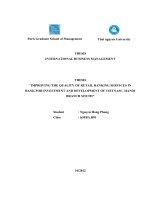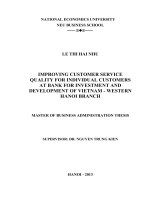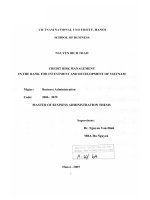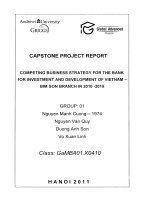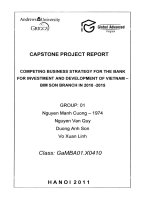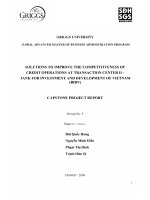Enhancing capital mobilization at joint stock commercial bank for investment and development of vietnam transaction center 1
Bạn đang xem bản rút gọn của tài liệu. Xem và tải ngay bản đầy đủ của tài liệu tại đây (791.71 KB, 86 trang )
ĐẠI HỌC QUỐC GIA HÀ NỘI
KHOA QUẢN TRỊ VÀ KINH DOANH
---------------------
PHẠM HỮU NAM
ENHANCING CAPITAL MOBILIZATION AT JOINT STOCK
COMMERCIAL BANK FOR INVESTMENT AND DEVELOPMENT
OF VIETNAM – TRANSACTION CENTER 1
TĂNG CƯỜNG HUY ĐỘNG VỐN TẠI NGÂN HÀNG THƯƠNG MẠI
CỔ PHẦN ĐẦU TƯ VÀ PHÁT TRIỂN VIỆT NAM – CHI NHÁNH
SỞ GIAO DỊCH 1
LUẬN VĂN THẠC SĨ QUẢN TRỊ KINH DOANH
HÀ NỘI - 2019
ĐẠI HỌC QUỐC GIA HÀ NỘI
KHOA QUẢN TRỊ VÀ KINH DOANH
---------------------
PHẠM HỮU NAM
ENHANCING CAPITAL MOBILIZATION AT JOINT STOCK
COMMERCIAL BANK FOR INVESTMENT AND DEVELOPMENT
OF VIETNAM – TRANSACTION CENTER 1
TĂNG CƯỜNG HUY ĐỘNG VỐN TẠI NGÂN HÀNG THƯƠNG MẠI
CỔ PHẦN ĐẦU TƯ VÀ PHÁT TRIỂN VIỆT NAM – CHI NHÁNH
SỞ GIAO DỊCH 1
Chuyên ngành: Quản trị kinh doanh
Mã số: 60 34 01 02
LUẬN VĂN THẠC SĨ QUẢN TRỊ KINH DOANH
NGƯỜI HƯỚNG DẪN KHOA HỌC: PGS.TS. PHẠM ĐỨC HIẾU
HÀ NỘI - 2019
DECLARATION
I undertake that this thesis “Enhancing capital mobilization at Joint
Stock Commercial Bank for Investment and Development of Vietnam Transaction Center 1” is my own independent research under the guidance of
Assoc. Prof. Dr. Pham Duc Hieu. All data used in the thesis analysis has a
clear, authentic and published source in accordance with regulations.
I will be responsible for my declaration.
Hanoi,..... day … month … 2018
Author
Pham Huu Nam
ACKNOWLEDGEMENTS
I would like to express my gratitude to the Faculty of Bussiness
Management –Vietnam National University, Hanoi, the Advanced Master’s
Degree Program and the teachers who helped me to complete the program.
and my thesis.
In addition, I would like to send my thanks to the Board of Directors
and all the colleagues of Joint Stock Commercial Bank for Investment and
Development of Vietnam - Transaction Center 1 for helping me access
documents and actual data of the branch. In particular, I also give special
thanks to Assoc. Prof. Dr. Pham Duc Hieu, who has read and edited the draft
thesis and helped me understand the theoretical basis and analyze the actual
capital mobilization and business conditions at the branch. Without them, I
could not complete my thesis.
I look forward to receiving feedback from teachers, friends and
colleagues.
Thanks and Best regards!
Yours sincerely,
TABLE OF CONTENTS
LIST OF ABBREVIATIONS................................................................................... I
LIST OF TABLES .................................................................................................. II
LIST OF FIGURES ............................................................................................... III
INTRODUCTION .....................................................................................................1
CHAPTER
1:
BASIC
THEORETICAL
ISSUES
OF
CAPITAL
MOBILIZATION OF COMMERCIAL BANKS ..................................................4
1.1 Activities of commercial banks ..........................................................................4
1.1.1 Concept and characteristics of commercial banks .........................................4
1.1.2 Basic operation of commercial banks ............................................................5
1.2 Capital mobilization of commercial banks .......................................................9
1.2.1 Concept of capital mobilization of commercial banks ...................................9
1.2.2. Capital mobilization forms of commercial banks .........................................9
1.2.3. Criteria for evaluating capital mobilization of commercial banks ..............13
1.3 Factors affecting the capital mobilization of commercial banks ..................17
1.3.1 Subjective factors .........................................................................................17
1.3.2. Objective factors ..........................................................................................21
CHAPTER 2: CURRENT STATUS OF CAPITAL MOBILIZATION AT
BIDV- TRANSACTION CENTER 1 ....................................................................27
2.1. Overview of BIDV - Branch Office 1 .............................................................27
2.1.1. Establishment and development history of BIDV- Transaction Center 1 ...27
2.1.2. Business results of BIDV- Transaction Center 1 ........................................28
2.2 Current status of residential capital mobilization at BIDV-Transaction
Center 1: ...................................................................................................................32
2.2.1. Capital mobilization at BIDV-Transaction Center 1 ...................................32
2.2.2 Capital mobilization cost at BIDV- Transaction Center 1 ...........................41
2.2.3 Net income from internal capital mobilization ............................................43
2.2.4 Forms of capital mobilization at BIDV- Transaction Center 1 ....................44
2.3 Evaluation of the current status of capital mobilization at BIDVTransaction Center 1 ..............................................................................................49
2.3.1 Achievements ..............................................................................................49
2.3.2 Limitations ....................................................................................................52
2.3.3 Causes of limitations ....................................................................................54
CHAPTER 3: SOLUTIONS TO ENHANCE CAPITAL MOBILIZATION AT
BIDV-TRANSACTION CENTER 1 .....................................................................61
3.1 Orientation for capital mobilization of BIDV- Transaction Center 1 in the
2018-2020 period .....................................................................................................61
3.1.1 Development orientation of BIDV –Transaction Center 1 ..........................61
3.1.2. Capital mobilization orientation of BIDV-Transaction Center 1 ................62
3.2. Solutions to enhance capital mobilization at BIDV-Transaction Center 1 .........63
3.2.1 Concentration on residential customers by diverisfying saving deposits ....63
3.2.2 Quality improvement of human resources ...................................................64
3.2.3 Renovation and perfection of utilities for depositors and customer care .....65
3.2.4 Application of the flexible interest rate regime and the promotion
mechanism .............................................................................................................66
3.2.5 Marketing and advertising promotion ..........................................................67
3.2.6 Diversification of capital mobilization products ..........................................68
3.2.7 Expansion of the retail banking service network .........................................69
3.3. Some recommendations ...................................................................................70
3.3.1. For BIDV .....................................................................................................70
3.3.2 For the State Bank of Vietnam .....................................................................71
CONCLUSION ........................................................................................................75
REFERENCES ........................................................................................................77
LIST OF ABBREVIATIONS
ATM
Automatic Teller Machine/ Automated Teller Machine
BIDV
Joint Stock Commercial Bank for Investment and
Development of Vietnam
SBV
State Bank of Vietnam
CM
Commercial bank
LC
Letter of credit
IO
Economic Organization
CI
Credit institution
JSC
Joint Stock Commercial
i
LIST OF TABLES
Table 2.1 Business results of Transaction Center 1 in the 2015-2017 period ..........29
Table 2.2: Capital mobilization growth rate of Transaction Office 1 .......................33
Table 2.3 Capital mobilization structure by object ...................................................34
Table 2.4: Capital mobilization scale of some branches in Hanoi City: ...................35
Table 2.5: Capital mobilization by currency .............................................................36
Table 2.6: Mobilized capital structure by maturity ...................................................39
Table 2.7: Capital mobilization interest rate (VND) at Transaction Center 1 ..........42
Table 2.8: Capital mobilization cost of BIDV- Transaction Center 1 in the 20152017 period................................................................................................................42
Table 2.9: Net income from internal capital mobilization of Transaction Center 1 in
the 2015-2017 period ................................................................................................43
Table 2.10: LIST OF DEPOSITS OF BIDV AND OTHER BANKS ......................45
ii
LIST OF FIGURES
Figure 2.1: Credit growth rate of BIDV – Transaction Center 1 in the 2015-2017
period .........................................................................................................................31
Figure 2.2: Scale of capital mobilization of BIDV – Transaction Center 1 in 20152017 period................................................................................................................32
Figure 2.3: Capital mobilization results by currency ................................................37
iii
INTRODUCTION
1. Rationale
Over the years, Vietnam has begun to implement international
commitments in the banking sector through the signing of international trade
agreements. Accordingly, Vietnam will step by step open and liberalize its
business in the banking sector, allowing foreign banks as well as domestic joint
stock banks to operate in Vietnam. According to a report of the State Bank of
Vietnam, there are 47 branches of foreign banks, 5 banks with 100% foreign
capital, 53 representative offices and 4 joint venture banks. The presence of
foreign banks with abundant financial capacity, diversified services is a big
challenge for domestic banks. Therefore, the competition among banks,
especially in the field of capital mobilization is increasingly fierce because
capital resources determines not only the scale of operation and competitiveness
but also expansion or narrowness of credit activity and direct impact on the
profitability of banks.
In addition, the Vietnamese economy is developing, people and economic
organizations have had more diversified choices in investment of their idle
money in the fields of securities, real estate, gold, foreign currency, etc.
However, the commercial bank system with the function of a financial
intermediate between savings and investment, between the excess capital and the
lack of capital is always a key capital mobilization channel for the economy.
Currently, BIDV - Transaction Center 1 (BIDV - Transaction Center 1) as
one of the leading branches in the BIDV system continues to affirm its position
in the currency business, in which the capital mobilization to meet the credit
needs is always highlighted and considered as one of the main activities.
Although the mobilized capital growth rate of Transaction Center 1 continuously
maintained at 10-13% over the past years, Transaction Center 1 still has some
limitations in the capital mobilization that is needed to be overcome to not lag
1
behind other banks. Firstly, the scale of residential capital mobilization is much
smaller than its potentiality; Secondly, the mobilized capital in foreign
currencies is still limited, accounting for a very small proportion of total
mobilized capital; Thirdly, the mobilized capital structure is not balanced and
fourthly, the mobilized capital is mainly from some major customers.
Recognizing the weaknesses and importance of capital mobilization to the
TC1’s
business,
“Enhancing
capital
mobilization
at
Joint
Stock
Commercial Bank for Investment and Development of Vietnam - Transaction
Center 1” was selected as the thesis topic.
2. Research objectives
The research purpose of the thesis is to analyze the current status, find
out the limitations and causes, thereby proposing solutions to enhance capital
mobilization at BIDV- Transaction Center 1. Specifically, the thesis has the
following objectives:
- Learn about the basic theory of capital mobilization activities of
commercial banks in the economy as a basis for analyzing the current status.
- Analyze and evaluate the current status of capital mobilization at
BDIV - Transaction Center 1 to find out the achievements and weaknesses,
thereby proposing the solutions to enhance capital mobilization at BIDVTransaction Center 1
3. Subject and scope of the study
Capital mobilization (mainly deposit mobilization) of commercial
banks
4. Scope of the study
4.1 Reseach contents
Capital mobilization in which the thesis focuses on mobilizing deposits
4.2 Spatial scope
The thesis focuses on studying into capital mobilization activities at
2
BIDV – Transaction Center 1.
4.3 Research time
The study is done for the 2015 - 2017 period
5. Reseach method
- Document review: This method is used to analyze and synthesize the
theoretical bases for capital mobilization of the Bank based on information
from books, newspapers and research works. ...
- Data collection: This method is used to collect the data needed for the
study.
- On the basis of the collected data, statistics comparison and data sythesis
methods are used to analyze the current status and specific indicators; thereby
assessing the achieved results and limitations in capital mobilization activities.
6. Scientific and practical significance of the thesis
- Theoretical significance: The thesis clarifies some basic theoretical
issues on capital mobilization of commercial banks
- Practical significance: On the basis of practical analysis, the thesis
proposes practical solutions to enhance capital mobilization at BIDVTransaction Center 1
7. Design of the thesis
In addition to the Introduction, Conclusion and References, the thesis
consists of three following chapters:
Chapter 1: Basic theoretical issues of capital mobilization of commercial banks.
Chapter 2: Current status of capital mobilization at BIDV-Transaction Center 1
Chapter 3: Solutions to enhance capital mobilization at BIDV-Transaction
Center 1
3
CHAPTER 1: BASIC THEORETICAL ISSUES OF CAPITAL
MOBILIZATION OF COMMERCIAL BANKS
1.1 Activities of commercial banks
1.1.1 Concept and characteristics of commercial banks
1.1.1.1 Concept
Banking is a form of organization that plays an important role in the
economy in general and each local community in particular.
According to Article 4 of Law on Credit Institutions No. 47/2010/QH12
adopted by the National Assembly of Socialist Republic of Vietnam on June
16, 2010:
“A commercial bank is a type of bank that carries out all banking
activities and other business activities as prescribed for profit purposes.” In
particular, “Banking activities are the business and regular supply of one or
more of the following operations: receiving deposits, granting credit and
providing payment services through accounts.”
Commercial banks can be defined in a variety of ways through the
functions, services or roles they perform in the economy. However, by
analyzing the content of those definitions, it is easy to see that commercial
banks have one thing in common: It is a financial intermediate that operates
by mobilizing capital through trust funds - demand deposits and term deposits
to use in credit services such as lending, discounting and other business
services of the Bank.
According to the Decree No. 49/NDCP on commercial banks,
“Commercial banks are credit institutions whose primary and regular
activities are to receive deposits, provide loans, payment facilities and other
banking services.”
4
The concept of commercial banks used in the thesis is as follows:
A commercial bank is a special enterprise operating in the monetary
sector with the main activity of capital mobilization, credit granting,
investment and service activities to gain one of the important objectives - the
profit maximization.
1.1.1.2 Characteristics
First of all, the main objective of commercial banks is to make profit and
pursue profit goals.
Commercial banks carry out two types of operations: currency business
and banking services. In particular, monetary business is expressed in the
capital mobilization in various forms to provide credit for customers with
capital needs. Commercial banks are “borrowers” to give loans for the
purpose of making profits. Banking activities are manifested through the
available operations of currency, payment, foreign exchange, securities to
perform certain tasks for customers in a certain period of time for the purpose
of collecting service charges or commission.
Secondly, commercial banks must comply with the law, which means
that commercial banks are allowed to operate in the market only when they
satisfies the strict conditions stipulated by law such as capital condition,
business plan, etc.
Thirdly, commercial bank operation is a far more risky form of business
than other forms of business and often has heavy impact on other industries
and the economy.
1.1.2 Basic operation of commercial banks
Being regarded as an important organization for the economy, the
banking system has rapidly developed and operated in three main areas to
meet the increasing demand of customers. These activities include: capital
mobilization, capital use and other activities
5
1.1.2.1 Capital mobilization
Capital mobilization is one of the most important and key activities of
commercial banks. It is the creation of capital from the receipt of deposits of
organizations and individuals; the payment, entrustment or the issue of
valuable papers to serve the lending and investment activities of the bank.
Capital mobilization is understood as attracting idle capital in the economy,
promoting money circulation. It reflects the financial strength that it can be
negotiated directly but also shows the weakness that is unsuitable in terms of
capital scale, leading to a waste of time and transaction costs. Through capital
mobilization, commercial banks have actually mobilized the combined power of
the economy in the process of production and circulation of goods. Thanks to
this activity of commercial banks, savings of individuals, economic
organizations are mobilized in the movement process of the economy.
Banks use the following capital mobilization operations:
Deposit mobilization: is the process of generating capital by
receiving the idle funds of individuals or households deposited in the Bank for
the purpose of gaining interest or opening deposit accounts to mobilize capital
from businesses for the purpose of payment or preservation of property.
Borrowing mobilization: is the process of generating capital by
borrowing credit institutions in the monetary market and the central bank in
the form of rediscount, secured loans, etc. for the purpose of creating a
balance in managing the capital of the commercial banks when they cannot
balance on the spot themselves.
1.1.2.2 Capital use
Capital use is the most important and main business activity of
commercial banks, mainly to bring profit to banks. The capital use by
commercial banks is to finance capital for enterprises, individuals and
6
organizations. In the market economy, the capital use is increasingly
diversified and implemented in various forms such as credit granting,
investment, etc.
Credit granting to customers
This is the basic direction in the bank’s capital use, including: lending,
financial leasing, discounting, factoring, bank guarantee and other credit operations.
Investment: This activity of commercial banks is implemented in
two main forms:
- Securities investment: The bank buys securities and becomes the
owner of the securities. Securities that the bank can buy are short-term
treasury bills, shares, government bonds and corporate bonds. Buying
securities brings benefits to the bank, which is the bank’s mobilized capital
use to maximize profits and enhance the solvency of its reserves. However,
commercial banks are only allowed to make investment in securities at a
certain limit in accordance with the law of the state.
- Investment in joint-venture and associated companies means the
bank’s contribution to joint venture with other credit organizations,
commercial banks or enterprises in the field of commercial production and
services to increase the capital contribution and generate advantages for banks
and the economy.
1.1.2.3 Other activities
In the current competitive environment, apart from the above activities,
commercial banks are actively searching for profits by implementing services
such as payment, foreign exchange, brokerage and securities business,
entrustment, financial consultancy, guarantee, equipment leasing, etc. These
activities bring about notable profits for banks.
Payment
7
A commercial bank provides payment services for customers, including
non-cash payments or cash payments through banks. It is a traditional
operation and is strongly developed in the market economy. Through this
activity, the bank collects charges and takes advantage of various sources of
capital through controlling cash flow in the national economy.
Securities business
Foreign currency trades in foreign currencies in domestic and
international markets. The bank’s profit is the difference between the ask
price and the bid price.
Securities brokerage and business
Banks act as the broker for banks to receive commissions
Entrustment
Banks follow the entrustment of customers in a number of tasks such as
asset management, agent and representative of economic organizations or law
enforcement agency.
Financial consultancy
The commercial bank is the center of money, credit and payment.
Besides, the bank is a quite full organization that always updates market
information, so it can provide the information requested by customers within
permissive limits. Commercial banks can give customers advice on
investment project, capital mobilization plan, corporate financial statement
analysis, etc.
Guarantee
The bank guarantees a certain ability- the solvency- of the guaranteed
party and commits the performance or compensation if the guarantor fails to
perform its ability.
Renting equipment, selling insurance services, preserving
valuable papers, ...
8
1.2 Capital mobilization of commercial banks
1.2.1 Concept of capital mobilization of commercial banks
Capital mobilization is an indispensable operation as it exists and develops in
parallel with the credit operation in business actitivies of commercial banks.
Capital mobilization is generating capital for most bank activities.
With their functions and tasks, commercial banks have attracted,
concentrated the temporarily idle funds of individuals and socio-economic
organizations. On the other hand, on the basis of mobilized capital, the banks
will carry out lending activities to meet the capital needs of the society.
Being introduced for a quite long time, constantly developing, changing
along with the development of commercial banks, the concept of capital
mobilization has changed considerably, both in terms of scale and forms.
Therefore, it is almost impossible to find out a complete definition of this
activity and there is no complete agreement between the viewpoints.
According to Clause 13, Article 4, Chapter 1 of the Law on Credit
Institutions (47/2010/QH12), deposit mobilization is the receipt of money
from organizations and individuals in the form of demand deposit, term
deposit, savings deposit, issue of certificates of deposit, promissory notes,
bills and other forms of deposit on the principle of full refund of principal and
interest to depositors as agreed.
1.2.2. Capital mobilization forms of commercial banks
Capital mobilization is a basic operation of commercial banks, also
known as capital creation in various forms to attract capital from
organizations and individuals in the economy to serve their business
activities. It is very important for each commercial bank to introduce suitable
and flexible forms of capital mobilization.
9
In the context of the thesis, we consider the most common form of
capital mobilization used in commercial banks - deposit mobilization.
Deposits are the capital resource accounting for the largest proportion
of a commercial bank, which is the foundation for its prosperity and
development. Deposit is also the only item on the balance sheet that
distinguishes the bank from other enterprises. Deposit is the main basis of
borrowings and loans; therefore, it is the foundation of profit and
development of the bank. There are many kind of deposits at banks. The
banks often compete with each other based on interest rates. In order to
increase the deposits in a competitive environment, banks have offered
various forms of capital mobilization:
Classification by currency
- VND capital mobilization: In mobilized capital, the VND capital accounts
for a high proportion through all forms of mobilization for different purposes.
- Foreign currency capital mobilization: the mobilized capital in foreign
currency converted to VND also accounts for a large proportion of the total
mobilized capital of the bank. The purpose of mobilizing capital in foreign
currencies is to diversify the mobilized money to meet the needs of
international payment as well as foreign currency business activities of
customers and banks.
- Gold mobilization: At present, beside domestic and foreign
currencies, some banks are mobilizing capital in gold. However, depending
on the regulations of the State Bank and each country, gold mobilization of
commercial banks must be permitted by the competent authority.
Classification by object
- Individual deposit
Individual customers account for a large proportion of the bank’s
objects. As a result, the bank’s banking services for this group are also
10
diversified, especially in capital mobilization. With the main purpose of
saving, property preservation and profitability, personal customers have
brought a large amount of mobilized capital to banks. For banks, i is a
relatively significant amount of capital and accounts for a large proportion of
bank deposits. This capital resource has the advantage of quite high stability.
- Corporate deposit
Apart from individual customers, the amount of capital mobilized from
corporate customers and economic organizations accounts for a large
proportion of total bank deposits. However, unlike individual customers,
enterprises usually only leave their balance on the payment account. In
addition, temporarily idle deposits are shown on term deposit accounts,
usually short term deposit accounts (week, day, month). Because this group’s
depositing purpose is to make payments as well as conduct other transactions,
the amount will not have a fixed term, which makes it difficult for the banks
to make a business plan for these funds.
- Deposit of other credit institutions
In fact, deposits of other credit institutions are commercial banks’
borrowings from such credit institutions in order to create their
competitiveness and solvency. In some cases, banks with a large amount of
mobilized capital can deposit into other banks for the purpose of enjoying a
portion of interests or regulatory interests from the Main Operation Centers of
such commercial banks, which helps them partially reduce costs ad bring
about higher profits to banks.
Classification by mobilization purpose
- Payment deposit (Transaction deposit)
Payment deposit is one of the oldest deposit services offered by banks.
It is the money of the individuals or enterprises deposited in the bank to
require the bank keep and pay costs on their behalf. Within the allowable
11
balance, the bank will meet the needs of individuals or enterprises.
Customers’ cash receipts are available upon request. In general, the payment
deposit interest rates are very low but the account holders can get low cost
banking services.
- Savings deposit
All classes of people have idle money and unused income. Under
conditions of access to the bank, they can open savings accounts at banks for
purpose of property conservation and profit. This source of funds is largely
maintained in a fixed period of time, so it is mainly used in commecial banks’
business activities. For most commercial banks, this kind of deposits account
for the highest proportion in their deposit structure.
- Term deposit (Non-transaction deposit)
Term deposits are savings accounts created to attract funds from
individuals or enterprises that wish to set aside funds for future financial
purposes. In general, this kind of deposit is essentially the same as savings
deposit. The interest rate applicable to this kind of deposit is much higher than
the payment deposit. Despite the high intest rate, the management and
maintenance cost for this kind of deposit is relatively low.
- Issue of valuable papers
Valuable papers are debt instruments issued by banks to mobilize
capital in the market. This capital resource is relatively stable and is aimed at
mobilizing a large competitive capital for existing products of other
commercial banks, so its interest is quite attractive. In addition, the interest
rate of this kind of deposit depends on the urgency of raising capital, so the
interest rate is usually higher than the ordinary term deposit interest rate.
Valuable papers issued by commercial banks are bonds, promissory notes and
certificates of deposit with par-value.
Classification by maturity
12
- Short-term deposit mobilization: This capital resource is mobilized in
less than 12 months.
- Medium and long-term deposit mobilization: This capital resource is
mobilized in 12 months or more. Normally, commercial banks pays interest
on medium and long-term deposits which are higher than short-term deposits.
Commercial banks can make more efficient business plans from the medium
and long-term deposits than short-term deposits.
1.2.3. Criteria for evaluating capital mobilization of commercial banks
To evaluate capital mobilization results, there are many groups of
measurement indicators, usually four main groups of indicators: scale and
growth rate of mobilized capital, mobilized capital structure, capital mobilization
cost, the relationship between capital mobilization and capital use.
1.2.4.1. Scale and growth rate of mobilized capital
Scale is an important indicator reflecting the capital mobilization
results of the bank, mobilized capital growth, thereby facilitating the bank’s
activities, improving liquidity and stability of capital resources.
Banks always keep the tight control of mobilized capital to ensure their
solvency and when there is a sudden need for capital, they must not mobilize
captial from other sources at a high cost. Normally, at the beginning of the
financial year, banks make a capital mobilization plan in the year and carry
out activities get the actual mobilized capital. Normally, some commercial
banks use the completion ratio of mobilization plan (symbol: THT) to evaluate
the scale of mobilized capital
THT (%) =
Total mobilized capital
Mobilization plan
%
If THT is below 100%, the mobilized capital is smaller than the planned,
the bank will have to mobilize capital from other sources (if necessary) to
13
supplement working capital as planned. In this case, the bank may lose more
costs or lose the opportunity to increase income due to failure to meet capital
needs in time. Conversely, if THT is over 100%, the mobilized capital is
greater than the planned, then the bank must try to use excessive capital
reasonably, otherwise the cost will increase due to interest payable of
excessive capital and other operating expenses while excessive capital is not
profitable. However, THT that is 100% is not always the best because it
depends on the bank’s actual capital needs in the year.
The scale of the mobilized capital should be developed for each
specific period, including capital increase plan, potential capital structure
change and new potential capital. The capital raising plan needs to be in line
with the bank’s capital use plan and expected return.
Capital growth rate
Total capital resources in year (n-1)
in year n(%)
Total capital resources in year ( n-1)
%
The higher growth rate of capital shows the more capital mobilized.
However, the scale and growth rate only partially reflects the capital
mobilization results because the scale of capital mobilization is usually only
considered at a certain time rather than a period; therefore, it does not
evaluate the stability of mobilized capital as well as the bank’s income from
these resources.
1.2.4.2. Mobilized capital structure
Capital mobilization results are also reflected in the mobilized capital
structure, which must be reasonable in line with the capital mobilization
objectives and strategies proposed by the bank and capital demand in terms of
object, maturity and currency. The rationality in capital structure is also a
condition for the Transaction Center 1 to implement and deploy its business
plans in a more profitable way.
14
When considering the structure of deposits, it is often considered the
ratio of capital mobilized from resources compared with total mobilized
capital, which is necessary for the banks to evaluae the capital mobilization
results because the interest rate, maturity, and stability of each specific
resource of funds will affect interest rate, maturity and stability of total
mobilized capital of the bank. This ratio is shown in the following formula:
Capital mobilization ratio of each
Mobilized capital balance from each
resource
resource =
%
Total mobilized capital
The mobilization and adjustment of this ratio will be subject to the
actual capital needs of each specific resource.
1.2.4.3. Capital mobilization cost
Banks are enterprises trading in money. Bank owners’ capital resources
often can not meet their business needs, so banks have to raise capital at a
certain cost. Valuation of mobilized funds or determination of mobilization
cost is an important task in the valuation process of commercial banks,
including mobilized capital interest rates and other costs related to
mobilization, in which interest is the important part that influences the scale
and performance results, accounting for a large proportion of the capital
mobilization cost. The capital mobilization cost shows how much the bank
needs to spend to raise such capital. This cost combined with the income from
the loan interest will indicate the bank’s income from the mobilized capital.
From there, by combining this income with the rate of return on mobilized
capital, banks may conclude mobilization results.
Capital mobilization cost is calculated as follows:
Capital mobilization cost = interest expense + non-interest expense
The mobilization interest expense is the cost that commercial banks
must pay to depositors. The interest expense is based on the nominal interest
15
rate announced to customers by the bank. This expense accounts for the
highest proportion of total operating expenses of the bank. This expense
depends on many factors such as maturity, type of deposit, depositing target,
trade strategy of the bank, add-ons, etc.
In addition to the mobilization interest cost, the bank also has to spend
a lot of other expenses for capital mobilization. Non-interest expenses are
diversified and are constantly increasing in the context that banks increase
their non-interest competition. Non-interest expenses include direct payments
to depositors such as gifts, sales promotion, lucky draws, insurance, etc.;
Utility costs for depositors such as opening branches, savings funds, counting
machines, counterfeit money detector for customers, at-home mobilization,
etc .; salary of staff of the departments; advertising and marketing expense to
attract depositors and other expenses that are included in the management
costs and are difficult to allocate for capital mobilization.
In order to measure the capital mobilization cost, commercial banks
often consider the average mobilization interest rates, i.e the interest paid by
banks to mobilize 1 dong to commercial banks and measured by the following
formula:
A
The average mobilization rate has a direct impact on the capital size of
the bank. Ordinaryly, the higher the average mobilization interest rate is, the
greater the mobilized capital is. However, with a large amount of mobilized
capital, the bank needs to have a reasonable capital use plan, ensuring the
highest profitability. Therefore, banks must have a reasonable cost structure to
not only attract depositors but also ensure the lowest cost for the profitability
of banks.
16
